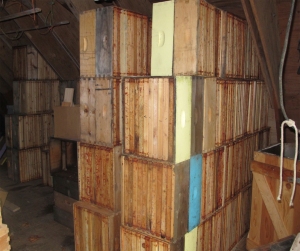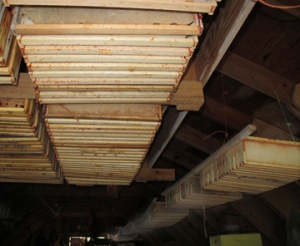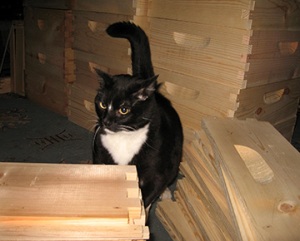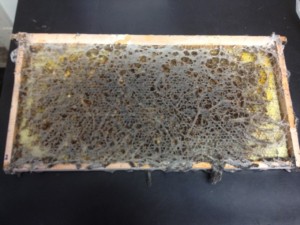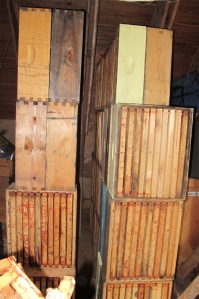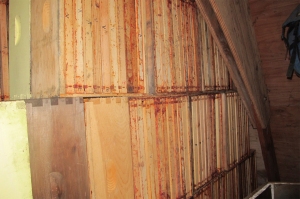I search continuously for easy, efficient, nontoxic ways to deal with bee equipment. Storing frames for winter has been an evolving technique. I am pretty happy with my new set up: stacking frames in boxes set on their sides.
When I had fewer hives, I used to hang my frames in the hayloft.
the line on the right is 40 feet long
Stacking is even easier, and equally efficient at keeping wax moths from settling on the the comb.
DRAWN COMB PREDATORS
I pull honey in August or September (that’s evolving too). We don’t see spring here until March at the earliest. So that means 5 or more months during which the supers’ frames are stored in my hayloft.
Mice and wax moths are my two main problems during this time.
Mice I’ve got covered
one of our predator control experts
The cats live in the barn. Before anyone becomes worried about them, it’s a 24 by 40 foot barn with a hayloft, hay, stored furniture and bee gear. Goats and livestock guard dogs who live on the ground floor provide “warming elements’. Along with fresh mice, the cats have their own giant kibble feeder, which probably brings mice, but, hey, even cats deserve an easy break in hunting. Mice? What mice? Haven’t seen one in the barn in years.
I don’t get wax moths either – due to hanging and stacking and our cold winters.
wax moth damage image
(courtesy of Jennie Stitzinger, beeinformed.org)
WINTER COLD HELPS STORED FRAMES
One thing that wax months don’t like is cold, freezing weather. Last year we didn’t have much of that, but it’s already begun this year. This is good for the local economy (we have some of the best skiing and snowboarding in the US) and good for wax frames in storage.
But wax moths can still be an issue if one creates nice, sealed, dark places for them to breed.
HANGING AND STACKING BEE HIVE FRAMES
I stopped hanging frames as my hive numbers increased. The technique worked really well, but it was time consuming.
In a long-lost article, I read about stacking hives on their edges. I gave it a try and it works.
The article said you could go three boxes deep. The author further suggested that one put a screen at either end. I think the screen was for mice…believe me cats are easier, effective and prettier (plus, some cuddle).
I go two boxes deep.
Two rows fit nicely
My barn has gussets – pieces of wood that stick out to allow more weight to fall on the roof without collapsing (did I mention it can snow here, a lot). Two supers on edge fit nicely between each gusset.
The boxes that face to camera are also two boxes deep – I was just running out of room, so I turned them 90 degrees.
Stacking boxes and frames in this way, also makes it easy to pull frames I want in the spring: I stack them with the top bars out, so it’s kind of like going to a frame “library”. I look at the dates of the frames, and page though to get an idea of what condition the frame is in.
I like stacking the frames. They are neat, tidy, and easily accessible. All ready for me when spring finally rolls around.
That’s the news from Brookfield Farm Bees And Honey in Maple Falls. What’s happening right now at the farm? Inverter trauma. We are an off-grid farm. I installed a new piece of equipment only to find that it really, really did not like my 20-year-old inverter. After a number of false starts, thinking that it was an issue of voltage (105 versus 110 – no other equipment cared), then maybe an imperfect ground, I discovered that the new equipment wanted pure sine wave, something that was created over the last two decades. So I’m buying a tiny inverter just for that piece of equipment. (A wonderful company, Backwoods Solar helped me sort this out. They’re great, they don’t mind answering questions at length.) OK, the world of inverters is not as gripping as beekeeping, but around here inverters are vital to our operation.
How’s your winter shaping up? Or in warmer climates – how are your bees doing?

